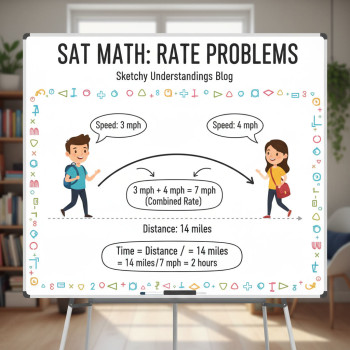Why Transportation Matters (More Than You Think)
When you picture your teen walking into their SAT test center, you probably imagine confident shoes, a steady backpack, and a face full of concentration. What doesn’t often come to mind is everything that had to go right before that office door opened: alarms, traffic lights, parking spots, substitute drivers, and the tiny human details that can turn a promising test day into a panicked scramble.
Transportation is not just about getting there. It affects arrival time, pre-test routines, stress levels, and — most importantly — the state of mind your student brings into the exam. This post gives parents a practical, step-by-step plan to manage transportation for the Digital SAT so test day runs like clockwork. We’ll cover prep, timing, contingency plans, and a few parent-tested sanity-savers. Whether you drive, carpool, ride public transit, or coordinate with neighbors, you’ll leave this article with a realistic, calm plan.

Two Big Things to Confirm Before You Decide How to Travel
1) Know exactly where the test center is and what time to arrive
Use the test center locator during registration and check the admission ticket for your student’s address and arrival time. Test centers often open early and have strict doors-closed policies: arriving late can mean no entry and forfeited test fees. For the Digital SAT, some centers have slightly different check-in procedures (for example, device setup timelines), so check whether your teen needs to arrive even earlier to complete any device steps.
2) Check logistics specific to that location
Every test center is a little different. Call or visit the site’s webpage a few days before the test to check:
- Where to park and if parking is free or paid.
- Nearest drop-off/pick-up point and whether there’s a no-idling rule at the entrance.
- If there are construction or traffic patterns that could add time on test day.
- Any special instructions for students who need to borrow a device or who have accommodations.
Practical Transportation Options — Pros, Cons, and When to Use Them
Option 1: Drive and park
Pros: Direct control over timing and pickup, familiar car environment for your teen, ability to bring last-minute items. Cons: Parking scarcity, early-morning rush, stress about being late.
- Best when: You live fairly close (15–30 minutes), parking is available near the test center, and you want control over arrival time.
- Tip: Pre-drive the route at the same weekday and time as test day to see real traffic and parking conditions.
Option 2: Drop-off (no parking)
Pros: Fast and minimal parking hassle. Cons: Tight timing if there’s congestion at drop-off points.
- Best when: Test center has a designated drop-off area or curb close to the entry door.
- Tip: If the center has a busy entrance, plan to arrive 10–15 minutes earlier than you would if parking; that buffer keeps drop-off from becoming a stressful three-point turn.
Option 3: Carpool with other families
Pros: Shares driving responsibilities and parking; familiar faces can comfort teens. Cons: Coordination required, potential for delays if anyone runs late.
- Best when: You have reliable neighbors or school friends who are punctual and have similar arrival time plans.
- Tip: Exchange phone numbers the night before; agree on a single backup plan (e.g., if someone is running 10+ minutes late, call the alternate driver).
Option 4: Public transit, rideshare, or taxi
Pros: Good when parking and driving are impractical. Cons: Transit delays, limited rideshare availability early morning, and additional cost.
- Best when: Test center is in a city served reliably by transit, and you plan ahead for transit times and possible delays.
- Tip: If using transit, do a full transit run at the same time of day as the test at least once before test week. If using rideshare, pre-book where possible and have a backup payment method in the driver’s app.
Timing Is Everything: Create a Realistic Test Day Timeline
Building a timeline backward from the test start time helps you avoid last-minute surprises. Below is a sample timeline for a standard SAT start time (doors open at 7:45 a.m.; check your student’s admission ticket for exact times). Adjust times for longer commutes or device-setup needs.
| Time Before Test | Action |
|---|---|
| Night before | Pack allowed items, set alarms, print admission ticket, confirm route, charge devices, and verify transportation plan. |
| 2–3 hours | Leave home if you have a longer drive (traffic-dependent); give a generous buffer for unexpected delays. |
| 60–90 minutes | Arrive at vicinity of test center — park or secure drop-off spot; find testing room if allowed; quick restroom visit and calm deep breaths. |
| 30–45 minutes | Check-in procedures begin — have necessary ID and admission ticket ready. |
| 15–0 minutes | Final bathroom break, quiet review of one-page cheat-sheet (not the content but a calming routine), and send-off. |
Adjust the timeline if your student must borrow or set up a device: some students are advised to arrive 30 minutes earlier for device setup and account login checks.
Night-Before and Morning-Of Checklists for Parents
Night before
- Confirm test center address, entrance, and arrival time from the student’s admission ticket.
- Pre-load navigation app with route and alternate routes; screenshot directions in case of poor signal.
- Check parking options and costs; budget change if meter parking is needed.
- Charge phones and devices. Prepare a small snack and water for after the test.
- Pack a small ‘calm kit’ for your teen: tissues, lip balm, a hand wipe, and a note of encouragement.
Morning of
- Verify you have the admission ticket, acceptable photo ID (if required), and any approved accommodations paperwork.
- Leave earlier than GPS suggests — traffic on test days can be unpredictable.
- Keep the car radio at a low, positive station; avoid last-minute tutoring or heavy review in the car.
- Send a quick, encouraging text and remind them to breathe and focus on their strategy, not perfection.
Contingency Planning: Expect the Unexpected
Good plans anticipate the hiccup. Here are practical contingencies to discuss ahead of time so neither of you is scrambling if things go wrong.
- Traffic or accident: Have two routes saved; if stuck, call the test center to explain—sometimes centers note late arrivals but can’t guarantee entry.
- Car trouble: Keep AAA or roadside assistance number handy; pre-arrange a neighbor or local parent who confirmed they can help as a backup driver.
- Rideshare no-shows: If you plan to rely on a rideshare, schedule one early and have a backup payment method and a backup driver prepared.
- Transit delays: Have an alternate mode (parent drive, neighbor) ready; if none is available, contact the school or center to explain and ask about options.
- Student forgets admission ticket/ID: Keep a printed admission ticket copy in your car or parent’s phone and bring your student’s ID or other proof of identity in case the center permits alternate verification.
Special Considerations for the Digital SAT
The Digital SAT requires device readiness. While most students will test on their own Bluebook-installed device or a school-managed device, some may need to borrow a device from the test center. That may require extra check-in time and forms.
- Confirm whether your student needs to borrow a device and, if so, what time they must arrive for setup.
- Make sure any student device meets College Board requirements if your teen brings their own device; keep charger and login details handy in a sealed bag.
- Allow extra arrival time for network checks and proctor device setup if your student has approved accommodations.
How Parents Can Help Without Micromanaging
Stress is contagious. Your calm is your teen’s most valuable pre-test asset. Here’s how to be helpful without crowding their focus:
- Own logistics, not content: Manage the travel plan, directions, parking, and timing. Leave test strategy and content confidence to your teen and their tutor.
- Be the anchor: Offer calm reassurances (“You’ve prepared; this is a long test, one section at a time.”) rather than performance-focused pep talks.
- After drop-off, do something to center yourself: a walk, coffee, or quiet reading. Your calm return at pickup makes a huge difference.
Real-World Examples and Mini Case Studies
Example 1: The Early-Commute Suburb
Problem: A suburban family lives 40 minutes from the test center where morning highway construction routinely adds 15–20 minutes.
Solution: They pre-drove the route at 7:00 a.m. on a weekday two weeks before the test, discovered a quicker side-street route, and agreed to leave 60 minutes earlier than GPS suggests on test day. They parked in a small free lot and used the buffer to let their teen calm down and hydrate before check-in.
Example 2: City Center, No Parking
Problem: An urban test center had limited parking and a loading zone often filled by parents.
Solution: The family set a drop-off spot two blocks away, practiced the short walk the week before, and arranged a meetup point for pickup. On test day, the parent used a local neighborhood map to plan a 12-minute buffer for pedestrian crossings and security lines.
Example 3: Borrowed Device Check-in
Problem: A student required a loaner device and needed to arrive 30 minutes early to complete a sign-in and device pairing process.
Solution: The parent and teen arrived 45 minutes early. The extra time avoided the stress of device pairing and allowed the proctor to complete checks without crowding. The student reported feeling more relaxed during the opening minutes of the test.
Tools and Tech That Make Transportation Easier
- Navigation apps: Save alternate routes and screenshot directions in case of poor cell service.
- Calendar reminders: Set reminders for leaving time, parking expiration, and check-in windows.
- Car apps: Use shared family location or ETA features sparingly — more useful for the parent picking up than for micromanaging the student.
- Printed backup: Keep a printed copy of the admission ticket, test center address, and both your and the test center’s phone numbers in the glovebox.
How Tutoring and Coaching Can Ease Transportation Stress
Many families focus tutoring on test content — which is crucial — but don’t forget the value of logistical coaching. A few practical things tutors and college coaches can do:
- Practice test-day routines so the student knows what to expect and is less likely to need last-minute cramming.
- Advise on device setup and compatibility so device-setup on test day is smooth.
- Provide emotional prep and timing strategies so the student is less likely to ask for last-minute review in the car.
Services like Sparkl’s personalized tutoring can help here: expert tutors provide 1-on-1 guidance, tailored study plans, and AI-driven insights that reduce content anxiety — which in turn lowers the chance your teen will insist on a last-minute review while you’re driving to the center. When both logistics and confidence are handled, test day becomes an organized, calm experience.
Pickup and Post-Test Logistics
Test sessions are long, and your teen will likely be tired afterward. Plan the pickup with the same care as the drop-off:
- Agree on a post-test meeting spot in advance — it makes exits smoother in busy centers.
- Allow time for debriefing: ask open-ended, non-judgmental questions like “How did it feel?” rather than “What was your score going to be?”
- Plan food: a healthy snack and water help the student recover quickly.
Final Notes: The Big Picture
Managing transportation to the SAT is a logistics puzzle that rewards a little thoughtful planning. The key ingredients are knowledge (exact address and arrival time), rehearsal (pre-drive or transit trial runs), buffers (leave plenty of extra time), and calm communication (your steady voice is powerfully reassuring).
Remember: the goal is to create the conditions for your teen to perform their best. Practical steps — pre-checking parking, verifying device needs, planning backup drivers — are the unsung heroes of a successful test day.
Consider pairing logistical planning with targeted academic support. Personalized tutoring — including 1-on-1 guidance, tailored study plans, expert tutors, and AI-driven insights — can make a meaningful difference in your teen’s confidence and readiness. When preparation is complete and transportation is sorted, both you and your student can approach test day with calm, practical confidence.
Quick One-Page Parent Checklist (Print This)
- Admission ticket: printed and saved on phone.
- Test center address: verified; alternate route saved.
- Parking/drop-off plan: confirmed and practiced if possible.
- Device needs: verified if student brings device or borrows one.
- Arrival buffer: plan to arrive at least 30–60 minutes early depending on commute and device setup.
- Emergency contacts: test center phone, alternate driver, and school counselor phone saved in your phone.
- Post-test meeting spot and snack packed.

Parting Thought
This moment — the pre-test drive, the last deep breath — is a chance to show your teen that preparedness and calm are daily skills. With a thoughtful transportation plan, clear contingencies, and a supportive tone, parents can remove friction from test day and let students do what they came to do: focus on the test itself. You’re giving them something far bigger than punctuality. You’re giving them space to perform.
Good luck to your student — and to you, the quiet logistics hero behind the scenes.












No Comments
Leave a comment Cancel